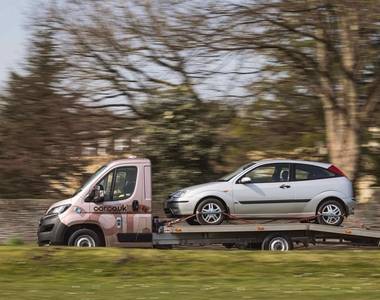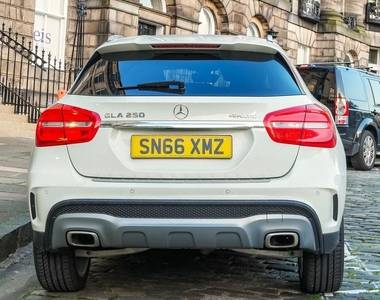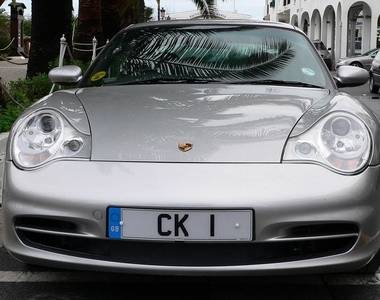Number plates are allocated to individual vehicles not their registered keepers. This means that when a car owner sells or has a car destroyed, the number plate stays with the car and is either used by its new owner or is scrapped along with the vehicle. It’s possible for a registered keeper to hang onto a licence plate, but they must apply officially to the Driver Vehicle and Licencing Agency (DVLA) and, for a fee, they can retain it and attach it to another vehicle of their choosing.
Number plates can tell you a wealth of information about a vehicle just by looking at them, including the age of a vehicle down to the year and month it was manufactured. It’s also possible to carry out comprehensive checks through Car.co.uk's MOT Check service. A search of this nature will offer more in depth details on a vehicle, including whether it’s taxed, when its MOT expires, the date it was initially registered and even its colour and engine size.
This online check through either Car.co.uk or the DVLA won’t answer the question “whose number plate is this?” however. To find out who is the registered keeper attached to a car’s registration number, you must contact the DVLA to request the information, but you’ll need what they refer to as a ‘reasonable cause’ to access this information. Examples of suitable reasons include if the vehicle has been involved in a traffic accident, if you are issuing traffic tickets or giving a notice of trespass charge, or tracing the owner of an abandoned vehicle, among others. If the number plate you’re trying to trace has been involved in a crime, you can also approach the police directly.
If you’re interested in number plates, what they can tell you, how to check them and how to discover just who the owner registered to them is, read on for the answers to some commonly asked questions.
Who owns this number plate?
Number plates aren’t issued to people but to vehicles in order for the authorities to identify them. These registration numbers are allocated by the Secretary of State who owns them. Today they are used as an integral part of the compulsory process of taxing and registering vehicles. The Secretary of State also has the right to withdraw a registration number.
As number plates are issued to vehicles and not their keepers, they stay with the vehicle until it is destroyed. However, a car owner can apply to officially keep the number plate and attach it to a new vehicle before scraping takes place or if the car is sold. This can be done by applying to the DVLA and sending the appropriate section of your V5C registration document, but it does carry a charge of £80. In effect, car owners have a limited entitlement to display a certain number plate while the vehicle is theirs.
How to search for a car number plate
Since September 2001, UK number plates have consisted of seven characters including letters and numbers. The exact format is two letters with two numbers followed by another three letters. The first two letters consist of a DVLA memory tag, the numbers describe the year and months the car was made and the last three letters are randomly assigned to identify an individual vehicle.
If you’re seeking a specific number plate, you can do so online through the government website. There you can easily use the DVLA’s resources to track down a car number plate in use. If you are looking for an unissued number plate then you can search current available stock of private reg plates right here at Car.co.uk.
A number plate check
Running a number plate check won’t tell you who the registered keeper of a car is, but you will be able to find out plenty of information about the car in question.
By running a check on a vehicle’s registration number, you can discover whether it’s taxed and if so, what its current tax rate is and when its tax runs out. You can also see if the vehicle has a valid MOT and when this is due to expire. The date when a vehicle was first officially registered can also be found through its number plate as well as the year it was manufactured. Additionally, a number of the vehicle’s basic specifications, like colour and engine size, can be quickly through the use of a number plate check, along with its carbon dioxide emissions statistics.
When a vehicle isn’t being used on the road, whether it’s being repaired, sold for parts or just sitting in a driveway or garage, it may have a Statutory Off Road Notice (SORN) attached to it. This can be seen by running a check of the number plate too.
How to check a number plate
Checking a number plate is a relatively simple task. The quickest way is online using the government website. You’ll find a page online where you are asked to enter the vehicle’s registration displayed on its plate. The online form is then sent to the DVLA’s data banks and instantly you’ll be supplied with a list of various details about the vehicle in question, from its colour to whether it’s completed its annual MOT. However, this check will not disclose the owner of the vehicle.
While checking a number plate is free online through the government website, for a fee you can also carry out an HPI vehicle history check, which may tell you far more about the vehicle. Along with discovering if there are any finance agreements attached to a specific car, an HPI check can tell you many other useful details about a vehicle’s history. If it’s been reported lost or stolen, or been involved in a crime or major accident, this will also be shown. HPI checks are always recommended before purchasing a car whether it’s from a dealership, private seller and especially when bought at auction. A fee of just £25 can buy you some peace of mind when you’re trying to make a purchase. Bear in mind, it’s worth checking what useful information the government can supply for free before running a paid HPI check.
Find a car owner by number plate
Under data protection laws, which protect an individual’s right to privacy, it’s not quite as simple to identify the owner of a specific number plate, and a quick registration plate check online via the DVLA will not turn up any results.
There may be many reasons you might like to find out who the owner of a car with a specific number plate is. You could be trying to find information on a vehicle that seems to have been abandoned near your home or maybe you want to trace a car that damaged your own in a collision, but either way you’ll need to take a different approach to discover who the car’s owner is.
You’ll need a valid reason for wanting to identify the number plate’s current owner and you’ll have to fill out the appropriate application form and make a payment for the service.
Check number plate owner
When you visit the government website page, which deals with checking number plates, you’ll see a section with information about identifying the registered keepers - both current or previous - of a vehicle. If you follow the link, you’ll find directions on how to request information on the car owner from the DVLA.
This application for information has to be made in writing and you must have what the DVLA describe as ‘reasonable cause’. Examples of these include if you’re trying to locate a car that was involved in a traffic incident or you’re looking to find the registered keeper of a vehicle that’s been abandoned. If a car has been left on your private land and you want to identify its owner this is also an acceptable reason for such a request.
Criminal issues, such as trying to trace number plates associated with drivers taking goods or services without payment, or those involved in insurance fraud, are other valid examples.
If you’re employed to issue parking notices or trespass notices, then you can request the registered keeper of a number plate from the DVLA, but your organisation must be a member of either the International Parking Community or the British Parking Community.
If you are an individual making a request to identify the registered keeper of a car you should apply by filling in a V88 form. If you’re part of an organisation tracing parking or trespass issues, then you should use a V88/3 form instead. There will also be a charge for this service outlined on the application form.











